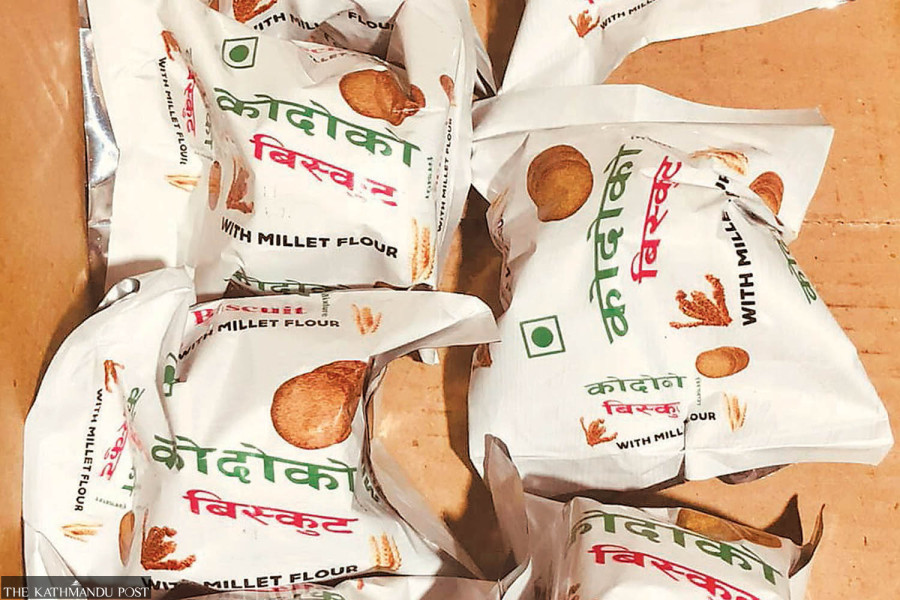Money
A Baglung youth is set to bring millet biscuits to urban shelves
Chansingh Srish’s millet biscuits aim to promote health and revive traditional grain cultivation.
Prakash Baral
Most of Chansingh Srish’s friends spent millions of rupees to go abroad in search of a better life. The 34-year-old from Kathekhola, Baglung, decided to test his luck at home by starting a business.
Srish, a commerce graduate who had dreamt of becoming a chartered accountant, opened a restaurant in Kathmandu five years ago.
Then Covid came and shut down his restaurant, forcing him to return to his hometown. There, Srish started thinking of pursuing a unique business. Millet was on his mind.
He began producing millet biscuits last January, but in a traditional way. When demand started to peak, he scaled up his enterprise. He currently employs ten people.
In Nepal’s Himalayan regions, millets are significant resilient cereal crops valued for their nutrition and adaptability to challenging climates. They contribute to food and nutrition security. However, their cultivation and consumption have declined due to shifting food preferences.
During the 1960s, people used to barter millet for cash, paddy, or other commodities because millet was considered less valuable than other cereals and seen as food of the poor.
Srish decided to challenge that perception by promoting millet and branding biscuits made from it. Reports show that millet consumption has several health benefits, such as lowering blood cholesterol, and preventing anaemia, since it is rich in iron. It also contains balanced methionine and sulphur amino acids, which are high in fibre, which supports a better digestion.
A year ago, he started his venture with a Rs1 million grant from the provincial government and a Rs1 million bank loan. Over the last seven months, he has scaled up his operations and started producing biscuits using modern techniques.
Srish said his investment has now reached Rs10 million. He named his venture Gaja Bakeries and Biscuits, which quickly became popular.
Since July, he has purchased a modern oven, along with packaging and labelling machines. He is now a commercial producer.
Before launching his venture, he visited a biscuit factory in Punjab, India, to gain insights. After millet, he plans to introduce potato biscuits to the market.
“I didn’t have a job after my graduation in Kathmandu. I ran a restaurant in Kathmandu for five years, but I was forced to return home during the Covid pandemic,” he said.
“At home, I researched millet biscuits and its market potential.”
The demand is huge, he said. “I see a very promising future for millet biscuits.”
He said he now sells 70-gram packets of millet biscuits for Rs20.
“The success of my venture means the demand for millet in the village will increase. Millet cultivation has been decreasing recently.”
He said demand for millet biscuits in the district market has increased, and samples have also been sent to supermarkets in Pokhara and Kathmandu for marketing. The biscuits he produced reached the market after being certified by the Department of Food Technology and Quality Control.
His factory can produce 60 kg of biscuits daily. The Agriculture Knowledge Centre supported him with packaging.
Srish often visits neighbouring districts, like Parbat and Baglung to procure millet.
A kilogram of millet costs Rs85.
As demand for millet has risen, farmers have also started cultivating the crop again.
“We normally used to cultivate vegetables and had stopped millet farming. But now we are receiving orders for millet,” said Lal Maya Pun, a local farmer. “Many other farmers have also started cultivating millet.”
Dhan Kumari Pun, an official of the Agriculture Knowledge Centre, said that in Tarakhola area in Baglung district, farmers have increased millet production.
According to the centre, in Baglung, millet is cultivated on 18,056 hectares, producing more than 32,000 tonnes annually.
“We aim to supply millet biscuits in every part of the country by expanding our factory capacity,” said Srish. “Millet biscuits are not only healthy, but also promote millet production.”




 16.09°C Kathmandu
16.09°C Kathmandu.jpg)















